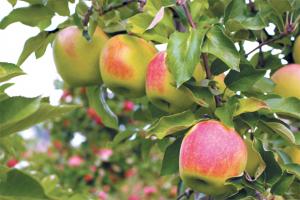Plant all apple trees in full sun in soil that drains
We stare at art and ponder how and why, and sometimes wonder what the heck? Many of the women painted by Michelangelo have decidedly male features, such as rippling biceps and strong muscular backs. No surprise since he used male bodybuilders for models. In Albrecht Dürer's painting "Virgin and Child With Pear," at the Uffizi Gallery in Florence, the Virgin is not holding a pear but instead a Muso di bue apple, or "ox's snout" apple.
That's right, an apple named after an ox snout. Muso di bue is grown only by a few old-time farms but once was quite common. Muso di bue apples are red with flecks of green. The small, firm fruit is crisp, with a sweet after taste. Traditionally grown in Italian pastures, they are often kept over the winter in local wheat warehouses. Beside eating fresh, or out of hand, these apples are cooked with pine cones and honey to create delicious cough syrups.
Then there is "Patte de loup" or "Wolf's Paw" apple from northwest France.
This is a rather small and somewhat misshapen fruit with rough, yellow-brown skin. Wolf's Paw apples are prone to cracking and other skin blemishes, but that hasn't stopped them from being grown since the Middle Ages because of its delightful, tart-sweet taste. This apple has firm, juicy, slightly yellow flesh that lends itself to being eaten out of hand. It is a good baking apple as well. Each apple has a distinct mark or scratch that gives credence to its name of wolf paw. Patte-de-loup apples grow on vigorous trees that bloom later than most, escaping many late frosts. It is a good keeper and, in fact, tastes best after storage, making it a wonderful winter apple. When fully ripe it gives off a rich aroma similar to fennel. While good as an eating apple, the Patte de loup holds up well as a baker, and can even accompany meat and game. Toss some with cut potatoes and bake for an amusing side dish. America has its own animal-faced apple, the Sheepnose or black gilliflower apple. Sheepnose trees bear large, oblong conical ribbed apples with a rich, dark nearly black-red skin. The yellowish-white flesh is crisp, slightly sweet and very aromatic. This is a dessert apple extraordinaire.
This old time variety originates from Connecticut in the 18th century. Sheepnose (or Sheep's Nose) is quite hardy and blooms with lovely pink white blossoms. It ripens in late September but should be picked immediately upon ripening or it will over-ripen and become mushy.
Plant all apple tres in full sun in soil that drains well. The ideal soil pH is 6.0 to 7.0, Before planting, soak the apple tree's roots in a bucket of water for two hours to rehydrate the plant and keep the roots from drying out while planting. Never soak the roots for more than six hours or you can kill the tree. Dig a hole deep and wide enough to hold all of the roots without bending them. Tamp the soil down firmly and water it well to eliminate any air pockets. Form a 2-inch high rim of soil in a wide circle around your newly planted apple tree. This earth berm collects water and lets it soak in slowly instead of running off and washing away the topsoil.
Grow something different in your apple orchard with Sheep’s Nose, Wolf Paw or Ox Snouts. While they may not end up in classical art work, they will indeed be the apple of your eye.



















































